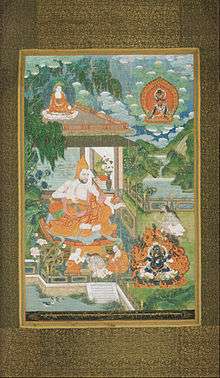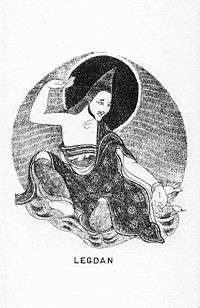Bhāviveka
Bhāviveka, also called Bhavya or Bhāvaviveka (traditional Chinese: 清辯; ; pinyin: Qīngbiàn;[2] Wylie: slob dpon bha bya, skal ldan, legs ldan , c. 500 – c. 578) was a sixth-century Madhyamaka Buddhist. In Tibetan Buddhism Bhāviveka is regarded as the founder of the Svātantrika tradition of the Mādhyamaka school of Buddhism, which is seen as antagonistic to Prāsaṅgika Madhyamaka.

Biography
The life details of Bhaviveka are unclear. He likely lived in early 6th century north India (c. 500-560 CE).[3] This, states Malcolm Eckel, was a period of "unusual creativity and ferment in the history of Indian Buddhist philosophy", when the Mahayana Buddhism movement was emerging as a "vigorous and self-conscious intellectual force" while early Buddhist traditions from the eighteen (Nikaya) schools opposed this Mahayana movement.[3]
Bhaviveka is notable in the Indian tradition for his inclusivist comments. He equated the Buddha's Dharma body with the Upanishadic concept of ultimate reality called Brahman,[4] but this view does not imply that he was a Vedantist or that he viewed Buddhism and Vedanta to be the same.[4] In his writings he comments on early Vedanta, and also addresses Hinayana (Theravada) accusations that Mahayana Buddhists are "crypto-Vedantins".[5][6]
Svātantrika school
Bhāviveka is retrospectively considered by the Tibetan tradition to be the founder of the Svatantrika tradition within Buddhism.[7][8][9]
Tibetan doxographers divided the Madhyamaka philosophy of Nāgārjuna into Svātantrika (svatantra: autonomous) and Prāsaṅgika (prasaṅga: consequence). This manner of division has been retroactively applied in Tibetan monasteries, and commonly found in modern secondary literature on Madhyamaka.[10] However, according to Dreyfus and McClintock, such a classification is problematic and was not used in India, where instead the "Svatantrika and Prasangika" schools were camped together then contrasted with "Santaraksita and Kamalasila"(Yogacara) schools of Madhyamaka Buddhism.[10] The former accepted "external objects exist", while the latter camp accepted "external objects do not exist".[10] The Svatantrika versus Prasangika sub-schools may have been an 11th–12th century innovation of the Tibetan translator "Patsab Nyima Drakpa" while he was translating a Sanskrit text by Candrakirti into Tibetan.[10]
According to Emmanuel this distinction has been discussed with the Prasangika school of Buddhapalita (470–550 CE) and Candrakirti(600–650 CE), and by 11th–century Buddhist scholars.[11]
Role of reasoning
In the Svātantrika tradition, reasoning is used to further explain that phenomena have no self-nature, and further arguments to establish that the true nature of all phenomena is emptiness. This school differs from the predominant Prasaṅgika tradition in that the latter refrains from making any assertions whatsoever about the true nature of phenomena.
The Padmakara Translation Group (2005: p. 386) convey a respected philosophical legacy, a dialectical chicane inaugurated by Bhāviveka:
Bhavya holds that the consequential arguments of Buddhapalita are not on the same footing as those of Nagarjuna. In both cases, the consequences imply negations that could theoretically be formulated as positive (syllogistic) arguments. The difference between them is that, given what is known to be Nagarjuna's intention (the negation of all four positions of the tetralemma), his negations are to be understood as ←. But such a concession is not to be granted to the commentator, whose task is to render explicit to the fullest extent the obscurities of the commented text. If the commentator uses consequences (unaccompanied by any positive and clarificatory statement), the resulting negations cannot automatically be regarded as nonimplicative. On the contrary, they are implicative and therefore undesirable in the Madhyamaka context...It is worth noting that it is in Bhavya that the important distinction between implicative and nonimplicative negations first appears.[12]
In the above quotation, "tetralemma" should be understood to refer to the catuṣkoṭi. "Nonimplicative negation" (Tibetan: མེད་དགག, Wylie: med dgag , Sanskrit: niṣedha) may also be rendered as "existential negation". "Implicative negative" (Tibetan: མ་ཡིན་དགག, Wylie: ma yin dgag ; Sanskrit: paryudāsa) may also be rendered "predicative negation".[13]
Panchen Lama lineage
In the lineage of the Panchen Lamas of Tibet there were four Indian and three Tibetan mindstream tulku of Amitābha before Khedrup Gelek Pelzang, 1st Panchen Lama. The lineage starts with Subhuti, one of the original disciples of Gautama Buddha. Bhāviveka is considered to be the third Indian tulku in this line.[14]
Works

Madhyamakahṛdaya-karika and its autocommentary, the Tarkajvala
Bhavya wrote an independent work on the Madhyamaka entitled the Madhyamakahrdaya-karika which Bhavya in turn wrote an autocommentary upon entitled the Tarkajvala (Blaze of Reasoning).[15]
His text Madhyamakahrdayakārikā and his commentary Tarkajvālā therein, states Malcolm Eckel, provide a "unique and authoritative account of the intellectual differences that stirred the Buddhist community in this creative period".[16]
Prajñāpradīpa (or Janāndeepa)
The Prajñāpradīpa (Wylie: shes rab sgron ma; or shes rab sgron me) is Bhāviveka's commentary upon Nagarjuna's Mūlamadhyamakakārikā.[17] The Sanskrit is no longer extant (except for a few embedded quotations in the Prasannapadā,[18] Candrakīrti's commentary of the Mūlamadhyamakakārikā and critique of the Prajñāpradīpa) but according to Ames (1993: p. 211) is available in both an excellent Tibetan translation, rendered by Jñānagarbha and Cog ro Klu'i rgyal mtshan (Wylie) in the early 9th century. Ames (1993: p. 211) also conveyed that the Chinese translation is poor, where the inference of inferiority was drawn from the work of Kajiyama (1963: p. 39).[19] The Sanskrit name has been reconstructed as either Prajñāpradīpa or Janāndeepa (where Janāndeepa may or may not be a Prakrit corruption or a poor inverse-translation, for example).
According to Ames (1993: p. 210), Bhāviveka was one of the first Buddhist logicians to employ the "formal syllogism" (Wylie: sbyor ba'i tshig , Sanskrit: prayogavākya) of Indian logic in expounding the Mādhyamaka which he employed to considerable effect in his commentary to Nāgārjuna's Mūlamadhyamakakārikā, entitled the Prajñāpradīpa.[17]
Wisdom Lamp (Prajñāpradīpa)
After the death of Buddhapālita (470–550), Bhāviveka refuted his views by writing a commentary on the Root Wisdom called Wisdom Lamp (Prajñāpradīpa) relying on Nāgārjuna's teachings. This text laid the foundations for the Svātantrika school.[20]
See also
References
- "1959-156-1: Acarya Bhavaviveka Converts a Nonbeliever to Buddhism". Philadelphia Museum of Art: Acarya Bhavaviveka Converts a Nonbeliever to Buddhism. Retrieved 5 October 2014.
- Xuanzang, Bianji (646). Great Tang Records on the Western Regions, vol.10.
- Malcolm David Eckel (Translator); Bhāvaviveka (2008). Bhāviveka and his Buddhist opponents: chapters 4 and 5 of Bhāviveka's Madhyamakahṛdayakārikaḥ with Tarkajvāla commentary. Harvard University Press. pp. 24–26. ISBN 978-0674032743.
- Bhāvaviveka; Malcolm David Eckel (2008). Bhāviveka and his Buddhist opponents: chapters 4 and 5 of Bhāviveka's Madhyamakahṛdayakārikaḥ with Tarkajvāla commentary. Harvard University Press. pp. 7–8.
- Nicholson 2010, pp. 152-153, Quote: "a Hīnayāna interlocutor accuses the Mahāyāna Buddhist of being a crypto-Vedāntin, paralleling later Vedāntins who accuse the Advaita Vedānta of crypto-Buddhism."
- King 1995, p. 183.
- S. K. Hookham (1991). The Buddha Within: Tathagatagarbha Doctrine According to the Shentong Interpretation of the Ratnagotravibhaga. State University of New York Press. pp. 354 note 76. ISBN 978-0-7914-0357-0.
- Jamgon Taye (2007). The Treasury of Knowledge: Book Six, Part Three: Frameworks Of Buddhist Philosophy. Shambhala. p. 42. ISBN 978-1-55939-883-1.
- Steven M. Emmanuel (2015). A Companion to Buddhist Philosophy. John Wiley & Sons. p. 114. ISBN 978-1-119-14466-3.
- Dreyfus, Georges B.J. & Sara L. McClintock (eds). The Svātantrika-Prāsaṅgika Distinction: What Difference Does a Difference Make? Wisdom Publications, 2003, pages 1-3
- Steven M. Emmanuel (2015). A Companion to Buddhist Philosophy. John Wiley & Sons. pp. 342–343. ISBN 978-1-119-14466-3.
- Shantarakshita (author); Mipham (commentator); Padmakara Translation Group (translators) (2005). The Adornment of the Middle Way: Shantarakshita's Madhyamakalankara with commentary by Jamgön Mipham. Boston, Massachusetts, USA: Shambhala Publications, Inc. ISBN 1-59030-241-9 (alk. paper), p.386
- Blumenthal, James (2009). 'Śāntarakṣita', The Stanford Encyclopedia of Philosophy (Fall 2009 Edition), Edward N. Zalta (ed.), Source: (accessed: Monday October 12, 2009)
- Stein, R. A. Tibetan Civilization, (1972) p. 84. Stanford University Press, Stanford, California. ISBN 0-8047-0806-1 (cloth); ISBN 0-8047-0901-7.
- Hoornaert, Paul (2000). "An Annotated Translation of Madhyamakahrdayakarika/ Tarkajvala V.8-26" (PDF). Studies and essays. Behavioral sciences and philosophy. 20: 75–111. Archived from the original (PDF) on January 30, 2014.
- Malcolm David Eckel (Translator); Bhāvaviveka (2008). Bhāviveka and his Buddhist opponents: chapters 4 and 5 of Bhāviveka's Madhyamakahṛdayakārikaḥ with Tarkajvāla commentary. Harvard University Press. p. Cover. ISBN 978-0674032743., Quote: "Bhāviveka (ca. 500–560 CE) lived at a time of unusual creativity and ferment in the history of Indian Buddhist philosophy. The Mahayana movement was emerging as a vigorous and self-conscious intellectual force, while the earlier traditions of the eighteen “schools” (nikaya) resisted the authority of the Mahayana and continued to elaborate the fundamental concepts of Buddhist thought. Bhāviveka’s “Verses on the Heart of the Middle Way” (Madhyamakahrdayakārikā) with their commentary, known as “The Flame of Reason” (Tarkajvālā), give a unique and authoritative account of the intellectual differences that stirred the Buddhist community in this creative period."
- Ames, William L. (1993). "Bhāvaviveka's Prajñāpradīpa ~ A Translation of Chapter One: 'Examinations of Causal Conditions' (Pratyaya)". Journal of Indian Philosophy, 1993, vol.21. Netherlands: Kluwer Academic Publishers, p.210
- Ames, William L. (1993). "Bhāvaviveka's Prajñāpradīpa ~ A Translation of Chapter One: 'Examinations of Causal Conditions' (Pratyaya)". Journal of Indian Philosophy, 1993, vol.21. Netherlands: Kluwer Academic Publishers, p.211
- Kajiyama, Yuichi (1963). 'Bhāvaviveka's Prajñāpradīpaḥ (1. Kapitel)(Fortsetzung)'. Wiener Zeitschrift für die Kunde Süd- und Ostasiens, vol.7: pp.37-62.
- "Indian Buddhist Pandits" from "The Jewel Garland of Buddhist History". Translated from the Tibetan by Lobsang N. Tsonawa, (1985) Library of Tibetan Works and Archives, Dharamsala, India, p. 15.
Further reading
- Eckel, Malcolm D. (1992). To See the Buddha. Princeton: Princeton University Press.
- Eckel, Malcolm D. (2008). Bhavaviveka and his Buddhist Opponents. Cambridge: Harvard University Press.
- Georges B.J. Dreyfus & L. Sara McClintock (2015), Svatantrika-Prasangika Distinction: What Difference Does a Difference Make?, Simon and Schuster
- King, Richard (1995), Early Advaita Vedānta and Buddhism: The Mahāyāna Context of the Gauḍapādīya-kārikā, SUNY Press
- Nicholson, Andrew J. (2010), Unifying Hinduism: Philosophy and Identity in Indian Intellectual History, Columbia University Press